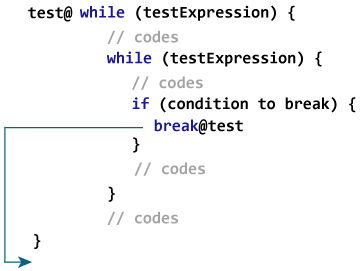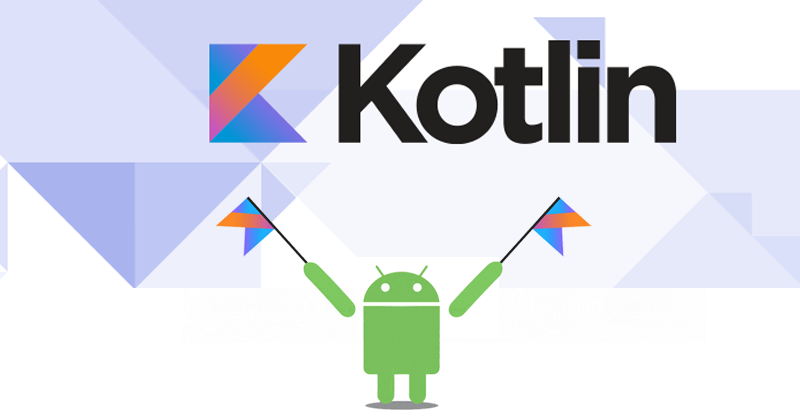Kotlin break Expression
In this tutorial, you will learn to use break to terminate a loop. Also, you will also learn about break labels.
Suppose you are working with loops. It is sometimes desirable to terminate the loop immediately without checking the test expression.
In such case, break is used. It terminates the nearest enclosing loop when encountered (without checking the test expression).
How break works?
It is almost always used with if..else construct. For example,
for (...) {
if (testExpression) {
break
}
}
If testExpression is evaluated to true, break is executed which terminates the for loop.

Example: Kotlin break
fun main(args: Array<String>) {
for (i in 1..10) {
if (i == 5) {
break
}
println(i)
}
}When you run the program, the output will be:
1 2 3 4
When the value of i is equal to 5, expression i == 5 inside if is evaluated to true, and break is executed. This terminates the for loop.
Example: Calculate Sum Until User enters 0
The program below calculates the sum of numbers entered by the user until user enters 0.
fun main(args: Array<String>) {
var sum = 0
var number: Int
while (true) {
print("Enter a number: ")
number = readLine()!!.toInt()
if (number == 0)
break
sum += number
}
print("sum = $sum")
}When you run the program, the output will be:
Enter a number: 4 Enter a number: 12 Enter a number: 6 Enter a number: -9 Enter a number: 0 sum = 13
In the above program, the test expression of the while loop is always true.
Here, the while loop runs until user enters 0. When user inputs 0, break is executed which terminates the while loop.
Kotlin Labeled break
What you have learned till now is unlabeled form of break, which terminates the nearest enclosing loop. There is another way break can be used (labeled form) to terminate the desired loop (can be outer loop).
How labeled break works?

Label in Kotlin starts with an identifier which is followed by @.
Here, test@ is a label marked at the outer while loop. Now, by using break with a label (break@test in this case), you can break the specific loop.
Here’s an example:
fun main(args: Array<String>) {
first@ for (i in 1..4) {
second@ for (j in 1..2) {
println("i = $i; j = $j")
if (i == 2)
break@first
}
}
}When you run the program, the output will be:
i = 1; j = 1 i = 1; j = 2 i = 2; j = 1
Here, when i == 2 expression is evaluated to true, break@first is executed which terminates the loop marked with label first@.
Here’s a little variation of the above program.
In the program below, break terminates the loop marked with label @second.
fun main(args: Array<String>) {
first@ for (i in 1..4) {
second@ for (j in 1..2) {
println("i = $i; j = $j")
if (i == 2)
break@second
}
}
}When you run the program, the output will be:
i = 1; j = 1 i = 1; j = 2 i = 2; j = 1 i = 3; j = 1 i = 3; j = 2 i = 4; j = 1 i = 4; j = 2
Note: Since, break is used to terminate the innermost loop in this program, it is not necessary to use labeled break in this case.
There are 3 structural jump expressions in Kotlin: break, continue and return. To learn about continue and return expression, visit:
- Kotlin continue
- Kotlin function
Python Example for Beginners
Two Machine Learning Fields
There are two sides to machine learning:
- Practical Machine Learning:This is about querying databases, cleaning data, writing scripts to transform data and gluing algorithm and libraries together and writing custom code to squeeze reliable answers from data to satisfy difficult and ill defined questions. It’s the mess of reality.
- Theoretical Machine Learning: This is about math and abstraction and idealized scenarios and limits and beauty and informing what is possible. It is a whole lot neater and cleaner and removed from the mess of reality.
Data Science Resources: Data Science Recipes and Applied Machine Learning Recipes
Introduction to Applied Machine Learning & Data Science for Beginners, Business Analysts, Students, Researchers and Freelancers with Python & R Codes @ Western Australian Center for Applied Machine Learning & Data Science (WACAMLDS) !!!
Latest end-to-end Learn by Coding Recipes in Project-Based Learning:
Applied Statistics with R for Beginners and Business Professionals
Data Science and Machine Learning Projects in Python: Tabular Data Analytics
Data Science and Machine Learning Projects in R: Tabular Data Analytics
Python Machine Learning & Data Science Recipes: Learn by Coding
R Machine Learning & Data Science Recipes: Learn by Coding
Comparing Different Machine Learning Algorithms in Python for Classification (FREE)
Disclaimer: The information and code presented within this recipe/tutorial is only for educational and coaching purposes for beginners and developers. Anyone can practice and apply the recipe/tutorial presented here, but the reader is taking full responsibility for his/her actions. The author (content curator) of this recipe (code / program) has made every effort to ensure the accuracy of the information was correct at time of publication. The author (content curator) does not assume and hereby disclaims any liability to any party for any loss, damage, or disruption caused by errors or omissions, whether such errors or omissions result from accident, negligence, or any other cause. The information presented here could also be found in public knowledge domains.

